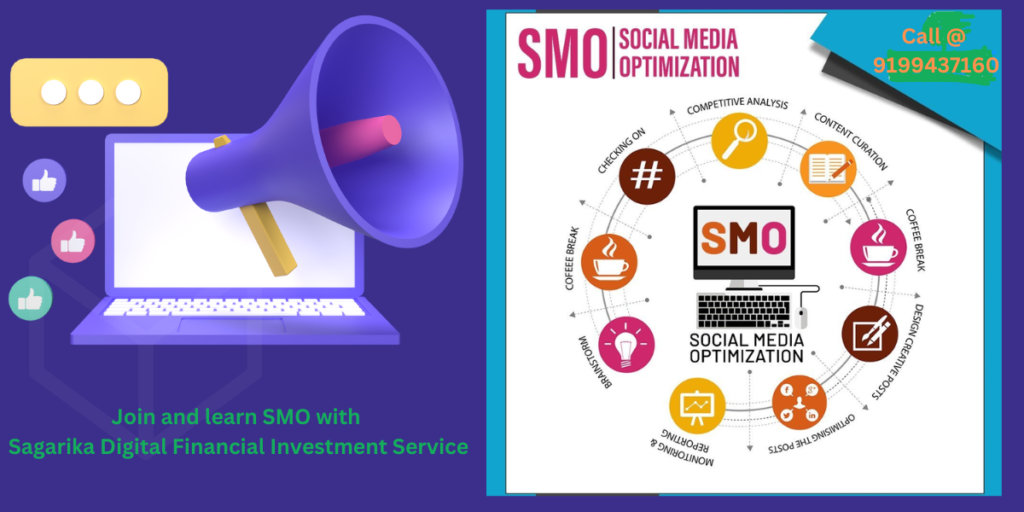Social Media Optimization

Social Media Optimization
Social media platforms are now an essential aspect of people’s lives in the digital age, and businesses cannot afford to ignore their potential. One of the most important tactics for increasing brand exposure and interaction on social media is social media optimization, or SMO. Search engine marketing (SMO) focuses on promoting and optimizing a brand’s social media presence to improve traffic, engagement, and brand awareness. This is in contrast to search engine optimization (SEO), which focuses on improving website ranks on search engines like Google. I’ll go over the main benefits of SMO for both individuals and corporations below.
The fact that social media optimization greatly raises brand recognition is among its most evident advantages. There are billions of active users across social media sites including Facebook, Instagram, Twitter, LinkedIn, and Pinterest. Through social media content optimization, businesses may expand their audience reach. For example, brands can increase their exposure by using hashtags, keywords, and well-written articles to make themselves appear more frequently in users’ social media feeds. More individuals become aware of the brand the more visible it is, which promotes long-term brand awareness.
The goal of social media optimization is to increase communication between a company and its target market. Interaction with the information increases with its level of engagement. Businesses can stimulate user participation and commenting by providing engaging material such as polls, quizzes, films, contests, and behind-the-scenes footage. Due to the fact that the majority of social media sites’ algorithms favor content with a high level of interaction, this engagement increases the company’s visibility there.
Additionally, consumer loyalty and a sense of community are fostered by interaction, increasing the likelihood of repeat business and brand evangelists.
Conventional marketing techniques like radio advertising, billboards, and TV commercials frequently call for large financial outlays. On the other hand, SMO provides a more affordable option. On the majority of social media sites, creating a profile and sharing content is free. Even sponsored advertising efforts with the extra benefit of precise targeting possibilities on social media sites like Facebook and Instagram are typically less expensive than traditional marketing.
By using SMO, startups and small businesses may compete with established brands by producing eye-catching content that appeals to their target audience without going over budget. Even the smallest companies in their industry are now able to establish a presence thanks to the democratization of marketing.
One of the main objectives of SMO is to drive traffic to a brand’s website. Social media platforms are excellent channels for sharing blog posts, product pages, and service offerings that link back to the main website. When users click on these links, they are directed to your site, increasing traffic.
Moreover, optimizing your social media presence improves the likelihood of your content being shared by users, increasing referral traffic. Through strategic sharing of valuable content, businesses can tap into viral marketing, where user-generated shares contribute to a massive influx of visitors to the website.
Search Engine Optimization (SEO) and Social Media Optimization (SMO) complement each other despite their differences. When ranking websites, search engines like Google are taking into account more and more social signals (likes, shares, and comments). Strong social media presence can aid in the creation of backlinks and boost branded searches, both of which have a beneficial impact on SEO, even though social media participation by itself might not immediately raise search engine ranks.
Additionally, businesses should make sure that their social media accounts appear for brand-related searches by building a strong brand presence on websites like YouTube, Twitter, or LinkedIn. A company’s online reputation can be greatly improved by this dominance of search engine real estate.
The capacity of social media platforms to target particular demographics, interests, and behaviors is one of its main benefits. With the advanced targeting capabilities provided by paid social media campaigns, businesses may customize their advertising to target the precise demographic they wish to attract. With this level of accuracy, businesses can make the most out of their marketing spend by limiting the audience that sees their material to those who are most likely to find it interesting.
Granular targeting is possible with Facebook Ads, for example, depending on age, gender, location, interests, online behavior, and even life events like birthdays and anniversaries. Because of its customization, social media marketing (SMO) is among the most effective ways to reach the right audience with the correct message.
Social media platforms offer precise insights and statistics, allowing businesses to monitor the performance of their content in real time. These insights include measures like reach, engagement, follower growth, link clicks, and audience demographics when they interact with the material.
Businesses can change their social media tactics in real time using this data. For example, if a post or ad is underperforming, it can be improved or replaced with new material that is more likely to resonate with the audience. This ability to adjust in real time leads to more efficient resource utilization and improved overall performance.
Establishing a strong social media presence enables firms to establish themselves as industry experts and leaders. Brands can gain credibility among their target audience by offering valuable, insightful, and relevant content. Consistently producing high-quality content, such as tutorials, how-tos, industry news, and intelligent commentary, can help a company establish itself as an authority in its sector.
Furthermore, social proof in the form of consumer likes, comments, shares, and testimonials is essential for developing trust. Consumers today are more likely to believe recommendations and evaluations from other users on social media platforms than traditional ads. By encouraging satisfied consumers to submit reviews and share their positive experiences, brands may increase potential customers’ confidence and trustworthiness.
Brands have a rare chance to communicate with customers directly through social media. Establishing more intimate and robust connections with their audience can be achieved by organizations through tailored replies, customer service engagements, and real-time conversations. SMO allows for two-way discussions, which allows firms to rapidly reply to client questions, concerns, and criticism. This is in contrast to other kinds of marketing, where communication is frequently one-sided.
Social media platforms also help businesses connect with customers by showcasing their personality and core beliefs. Customers are more likely to remain loyal to a brand that they feel understands and values them, which is why this emotional connection promotes loyalty.
The ability for material to become viral is one of social media’s most potent effects. Businesses can employ social media optimization (SMO) to produce shareable content that people may circulate extensively. Brand awareness and reach can rise exponentially as a result of viral content. A single post, meme, or video that strikes a chord with a large number of people, for example, has the potential to be shared hundreds or even millions of times, greatly increasing brand visibility.
Because people are more likely to trust information that has been recommended by friends or family, social sharing provides credibility to the business. SMO significantly increases the likelihood that a brand’s content will go viral, even though virality cannot always be anticipated or managed.
In summary
Social media optimization is an effective technique that companies can use to increase their consumer engagement, attract a wider audience, and better their digital presence in general. Brands may more effectively interact with their audience, increase website traffic, and raise brand awareness by optimizing social media content and utilizing the distinctive qualities of each platform.
It is impossible to exaggerate the significance of maintaining a strong social media presence in an increasingly digital environment. SMO gives companies the chance to connect with a worldwide audience and create enduring bonds with their clients. SMO is a vital tactic for any company hoping to succeed in the contemporary marketplace because of its many benefits, which include enhanced SEO, real-time engagement, and the possibility for viral marketing.
